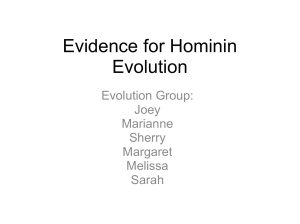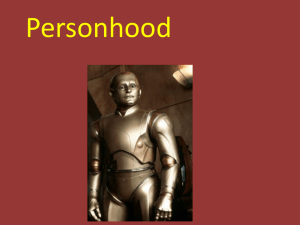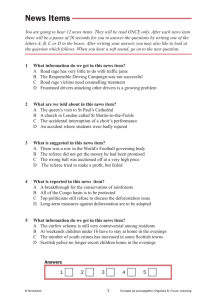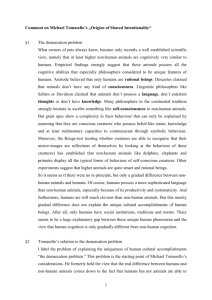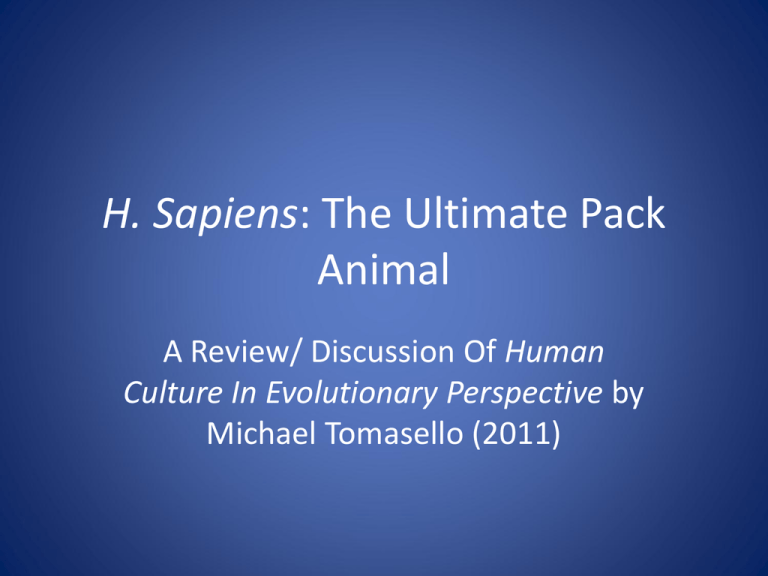
H. Sapiens: The Ultimate Pack
Animal
A Review/ Discussion Of Human
Culture In Evolutionary Perspective by
Michael Tomasello (2011)
The Problem At Hand
• If culture is viewed as simply the social
transmission of behavior, then there are many
examples of seemingly cultural behavior
throughout the animal kingdom
• This leads to the question “What’s so special
about us?”
Cultural Behavior?
The Answer
• Tomasello says we are different because of our
capacity for “shared intentionality”
– “…the ability and motivation to form shared goals and
intentions with others in collaborative activities, and
the ability and motivation to share experience with
others via joint attention, cooperative
communication, and teaching” (p. 6)
• Uses comparative research to show how smallscale human groups are different from other
primates and great apes, focusing mainly on
chimpanzees
Subsistence
• While other great apes forage in groups, not actually a
group activity
– More likely done as protection from predation
• “Group” hunting of monkeys by chimpanzees
– More likely a group of individuals trying to get the meat
first
– Any “sharing” done of the meat by monkey hunting
chimpanzees is done to prevent conflict
• Cost-benefit analysis
• Within small-scale human groups, cooperation and the
sharing of food are expected
• http://www.youtube.com/watch?v=Pro6X_Kc5wA
Economy
• Chimps and other great apes trade in favors
(food, sex, grooming, coalitional support),
whereas humans also trade stuff
• “Ownership” does not exist in other great ape
social groups
– Physical possession or proximity the closest thing
(always tenuous)
• “Human ownership… is a fundamentally cooperative
arrangement in which everyone agrees to respect others’
rights.” (p.11)
Child Care And Social Behavior
• Chimpanzees and the other great apes are
cooperative to limited degree
– When food comes into the picture, forget it
– Chimpanzee mothers frequently thwarted their
offspring’s attempts to get food from them
• When they actually shared with their offspring, the kid
got the short end of the stick (peel, husk, etc.)
• Humans are “cooperative breeders”
– Cooperative breeding facilitates the development
of families and unique attachments
Family
Communication And Teaching
• • “It comes so naturally to humans that we do not
think of it as cooperative behavior at all, but the free
exchange of information in humans is premised on the
cooperative assumption that a communicative act
provides useful or relevant information not for the
speaker but for the listener” (p. 15)
• Chimps and other great apes do not engage in, or
understand, cooperative communication because of
their competitive evolutionary history
– Communication likely self-serving
• Communication establishes and maintains small-scale
human groups through teaching
Politics
• The social systems of the other great apes are built around a
dominance hierarchy and ever-present threat of retaliation.
• “The main mechanism for keeping peace among great apes is that if
one individual harms another… the victim will quite often retaliate
(within the constraints of any dominance relations at play).” (p. 18)
• Intergroup relations – not so good
• Small-scale human groups have norms that keep dominant
individuals in check
• “…powerful individuals often obtain and retain their power not by
dominating resources directly in the manner of other great apes,
but by demonstrating both their ability to control resources and
their cooperative propensities by distributing resources generously
to others” (p. 19).
• Third-party enforcement important for group cohesion
• Trade and intermarriage reduce intergroup conflict in humans
Chimpanzee Dominance Display
• http://videos.howstuffworks.com/animalplanet/27871-almost-human-maledominance-in-chimps-video.htm
Norms And Institutions
• • “…the most distinctive feature of human social
organization is its normative structure. Human beings
do not just have statistical expectations about what
others will do—which all apes have—they also have
normative expectations about what others should do”
(p. 19)
• “Policing” found in chimpanzees may actually be the
dominant individual striving to keep dominance, but
may be an evolutionary precursor to third-party
enforcement
• Norms and institutions help foster group cohesion
Transmission Of Social Behavior/Social
Learning
• While many great apes seem to exhibit cultural
behavior, this can be more readily explained by
observational learning, since direct teaching is not
involved
• Humans are more actively involved in the process of
social transmission
• When taught a task, chimps more concerned with the
end result, whereas human children are more
concerned with proper procedure
• “This normative dimension to cultural traditions serves
to further guarantee their faithful transmission across
generations.” (p. 29)
Adapted For Culture
• Research has found that when compared on test
of cognitive ability, human infants perform
comparably to the other great apes on things
pertaining to the physical world, but exceed them
in things pertaining to the social world
• The advanced theory of mind of H. sapiens is an
important element of this
– The ability to infer the mental state of others
– Competitively oriented in other great apes, while
cooperatively oriented in humans
Adapted For Culture Cont’d
• Human collaboration is facilitated by language, gestural
communication, and the ability to mentally view activities
from multiple perspectives
• Cross-cultural research as found children develop similarly
in there social-cognitive skills initially, with cultural and
experiential differences coming later in development
• “Children must be equipped to participate during ontogeny
in this huge groupthink process by species-unique cognitive
skills for collaboration, communication, and cultural
learning, which coevolved with human cultural organization
during relatively recent evolutionary history. These basic
skills are universal across all cultural settings, and indeed, in
an important sense, make human culture possible in the
first place.” (pp.38-39)
The Evolutionary Origins Of Culture
• Ecological pressures forced humans to become
“obligate foragers”
• Humans then began a process of “self-domestication”
by punishing/shunning overly aggressive individuals
and/or by cooperative breeding
• Eventually, human groups began to develop norms and
institutions that bound them together as they
competed with other groups, and the most cohesive
groups prospered
• White sclera of human eyes may be a physiological
adaptation that facilitates cooperation
The Evolutionary Origins Of Culture
Cont’d
• While culture is the result of biological
evolution, it’s subsequent influence on human
evolution cannot be overstated. Culture can
be considered an evolutionary force in its own
right (Richerson & Boyd,2005)
Some Related Research
• http://www.physorg.com/news/2012-01hunter-gatherers-social-networks-evolutioncooperation.html
Examining The Miracle
• The events in Alive (1974/2005) would not have been possible
without the human ability to develop culture with its norms, etc. via
shared intentionality.
• Through shared intentionality, the group divided itself into subgroups with differing tasks that were ultimately geared toward
survival
• The circumstances the group encountered are loosely analogues to
those that our ancestors are hypothesized to have faced early in
human evolution, and so this instance can be utilized when
examining the evolution of human cooperation and culture
• Within the culture the survivors created, the consumption of
human flesh was viewed as acceptable under certain circumstances
Examining The Miracle Cont’d
• As an aspect of cultural behavior, religion is
hypothesized to have evolved in part because it
facilitated group cohesion (Rossano, 2010)
– Saying the rosary nightly
• Through making the consumption of human flesh
a form of communion, the group was
“supernaturalizing social life” and increasing their
cohesion (Rossano, 2010)
• Their common religious upbringing helped
facilitate the groups cohesiveness, and ultimately
contributed to their survival
Examining The Miracle Cont’d
– Certainly their quarrels were never serious when compared to the
strong bond of their common purpose. Especially when they prayed
together at night they felt an almost mystical solidarity, not only
among themselves, but with God. They had called to Him in their
need and now felt Him close at hand. Some had even come to see the
avalanche as a miracle which had provided them with more food.
This union was not just with God but with the friends who had died
and whose bodies they were eating to survive. Those souls had been
called to heaven because their work on earth had been done, but all
who were now living would quite happily have exchanged roles.
Nicolich, before the avalanche, and Algorta, while suffocating beneath
the snow, had both been prepared to die and bequeath their bodies to
their friends. It was also, as Turcatti said to the three others in the
conversation about Christ’s ordeal in the desert, that their condition
on the mountain was so terrible that any other would be better- even
death (pp. 193-194)
Questions For Me?
My Questions For You
• What factors do you think ultimately
contributed to the survival of those in Alive?
• Is there something other than shared
intentionality that you think makes us human?
• Do you think Tomasello glosses over human
conflict?
• Do you think Tomasello dismisses the idea of
culture in the other great apes too readily?
• Do you agree with my interpretation of
Tomasello’s thesis?
References
• Reid, P. P. (1974/2005). Alive. New York: Harper
Perennial
• Richerson, P. J. & Boyd, R. (2005) Not by genes
alone: how culture transformed human evolution.
London: The University Of Chicago Press
• Rossano, M. J. (2010). Supernatural selection.
Oxford: Oxford University Press
• Tomasello, M. (2011). Human culture in
evolutionary perspective. In M. Gelfand (Ed.)
Advances in culture and psychology. Oxford:
Oxford University Press
Video References
• BBCWorldwide. (2007, August 2). Hunter gatherers: tribe.
Retrieved from
http://www.youtube.com/watch?v=Pro6X_Kc5wA
• How Stuff Work. Almost human: male dominance in
chimps. Retrieved from
http://videos.howstuffworks.com/animal-planet/27871almost-human-male-dominance-in-chimps-video.htm
• Physorg. (2012, January 25). New study of huntergatherers suggests social networks sparked evolution of
cooperation [Web log post]. Retrieved from
http://www.physorg.com/news/2012-01-hunter-gathererssocial-networks-evolution-cooperation.html
Image References
•
•
•
•
Bonobo termite fishing. Retrieved from
http://www.google.com/imgres?q=animal+culture&hl=en&gbv=2&biw=1280&bih=923&tbm=isch&tbnid=bchZ4T
D1N0YymM:&imgrefurl=http://en.wikipedia.org/wiki/Animal_culture&docid=a6xcD1kol9_4VM&imgurl=http://upl
oad.wikimedia.org/wikipedia/commons/thumb/4/47/BonoboFishing05.jpeg/220pxBonoboFishing05.jpeg&w=220&h=165&ei=C7ElT8TVCpDqtgeBwvyiCw&zoom=1&iact=hc&vpx=213&vpy=176&dur
=309&hovh=132&hovw=176&tx=76&ty=62&sig=106676539912348877244&page=1&tbnh=125&tbnw=162&start
=0&ndsp=30&ved=1t:429,r:0,s:0
Chimp nut cracking. Retrieved from
http://www.google.com/imgres?q=Chimps+cracking+nuts&hl=en&biw=1280&bih=923&gbv=2&tbm=isch&tbnid=E
atvUa8KjVVdpM:&imgrefurl=http://mahale.main.jp/PAN/13_2/13(2)_02.html&docid=S3BzOs0rbBCYcM&imgurl=h
ttp://mahale.main.jp/PAN/13_2/13(2)_06.jpg&w=500&h=365&ei=1a8lT9zLouCtgfkr5WiCw&zoom=1&iact=rc&dur=420&sig=106676539912348877244&page=1&tbnh=130&tbnw=162&star
t=0&ndsp=28&ved=1t:429,r:3,s:0&tx=67&ty=68
Chimpanzee family. Retrieved from http://www.fond-ecran-image.com/en,Chimpanzees-190809-0041-1m1024x768,galerie-membre,singe-chimpanze,chimpanzes-190809-0041-1m-1024x768jpg.php
Human family. Retrieved from
http://www.google.com/imgres?q=family&start=45&num=10&hl=en&gbv=2&biw=1280&bih=923&tbm=isch&tbni
d=jEVp4tcGRBF3sM:&imgrefurl=http://www.graphicshunt.com/clipart/search/1/family.htm&docid=A8Ij1OyeH622M&imgurl=http://images.paraorkut.com/img/clipart/images/f/family_cooking872.gif&w=500&h=402&ei=4L0lT9auKsbEtweZ6MCgDA&zoom=1&iact=rc&dur=459&sig=10667653991234887724
4&sqi=2&page=3&tbnh=160&tbnw=199&ndsp=25&ved=1t:429,r:21,s:45&tx=51&ty=93


